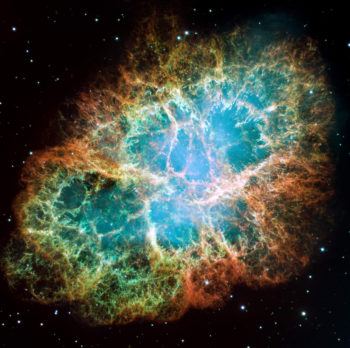Why Some Stars End Life In A Bang

By studying the events that precipitate gas explosions on Earth, a team of researchers led by Texas A&M University associate adjunct professor Alexei Poludnenko may have uncovered why some stars, known as white dwarfs, end their lives by detonating violently in a supernova explosion.
Although the conditions within these stars are vastly different from those on Earth, the researchers have shown in the November issue of Science that the basic mechanisms that set off detonations in stars are similar to those that trigger terrestrial explosions. Consequently, their findings might help in taking preemptive steps to avert explosion-related accidents and also advance novel propulsion and energy conversion systems here on Earth.
For this study, the researchers developed a theory of detonation initiation in gases based on the concept of turbulence, simply defined as a chaotic and rapid motion of parcels of air or liquid. In an ignited gas, turbulence can rapidly mix unburned fuel with hotter products of burning. As a result, the rate of burning and energy release is vastly accelerated.
“Turbulence action in these flows is similar to what happens when we add cream to coffee. Left alone, the cream takes a long time to mix with the coffee,” said Poludnenko, associate adjunct professor of aerospace engineering in the Department of Engineering and associate professor of mechanical engineering at the University of Connecticut. “But if we stir it with a spoon, we can cause turbulence; so, the motion of the spoon forces the cream and coffee to move faster, greatly accelerating their mixing.”
To investigate if turbulence could be a reason why volatile gases detonate, the research team designed an experimental setup consisting of a 1.5 meter-long channel with a spark plug installed on one end. Along the length of the chamber the researchers positioned perforated plates at different carefully chosen locations. The plates were designed to promote turbulence in a flammable gas mixture. After igniting the gas, researchers measured the speed of the resulting flame, along with the pressure generated by it, at different locations along the chamber.
Poludnenko and his team observed that the experimentally-induced turbulence within the chamber caused the flame to become unstable, accelerating rapidly and creating shock waves that traveled much faster than the speed of sound. As their theory predicted, these shock waves grew in strength and sped up the rate of burning even more, eventually causing a detonation.
Since their theory described gas detonations well, the researchers next investigated if the same theory could also explain stellar explosions, that is, the detonation of material undergoing nuclear fusion inside white dwarf stars. Upon simulating the turbulent conditions in the blistering core of these stars, Poludnenko and his team found that their theory predicted that much like the events leading up to gas explosions, turbulence can also cause supersonic shockwaves within the star. These waves force the star to chew through its nuclear fuel vigorously, triggering a massive detonation that ultimately blows up the star within a few seconds, producing an explosion capable of outshining the entire galaxy.
Poludnenko noted that while their findings have numerous applications in cosmology and astrophysics, their work also has important applications on Earth as well.
“We’d like to use our theory to predict why and when explosions on our planet will happen,” he said. “If we can accurately calculate the propensity for detonations in industrial settings, for example, we can fine-tune our safety procedures and hopefully circumvent major catastrophes.”
Other contributors to the research include Jessica Chambers and Kareem Ahmed from the Department of Mechanical and Aerospace Engineering, University of Central Florida; Vadim Gamezo from the Naval Research Laboratory, Washington, D.C.; and Brian Taylor from the Air Force Research Laboratory in Florida.
This work was supported by grants from the Energy, Combustion and Non-Equilibrium Thermodynamics Portfolio of the Air Force Office of Scientific Research in the areas of turbulent combustion and detonation, NASA, and the Alpha Foundation for the Improvement of Mine Safety and Health.
This article by Vandana Suresh originally appeared on the College of Engineering website.





